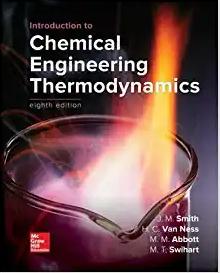Reagent-grade, liquid-phase chemicals often contain as impurities isomers of the nominal compound, with a consequent effect on
Question:
Reagent-grade, liquid-phase chemicals often contain as impurities isomers of the nominal compound, with a consequent effect on the vapor pressure. This can be quantified by phase-equilibrium/reaction-equilibrium analysis. Consider a system containing isomers A and B in vapor/liquid equilibrium, and also in equilibrium with respect to the reaction A → B at relatively low pressure.
(a) For the reaction in the liquid phase, determine an expression for P (the “mixture vapor pressure”) in terms of PsatA , PsatB , and Kl , the reaction equilibrium constant. Check the result for the limits Kl = 0 and Kl = ∞.
(b) For the reaction in the vapor phase, repeat part (a). Here, the relevant reaction equilibrium constant is Kv.
(c) If equilibrium prevails, then whether the reaction is assumed to occur in one phase or the other makes no difference. Thus the results for parts (a) and (b) must be equivalent. Use this idea to show the connection between Kl and Kv through the pure-species vapor pressures.
(d) Why is the assumption of ideal gases and ideal solutions both reasonable and prudent?
(e) Results for parts (a) and (b) should suggest that P depends on T only. Show that this is in accord with the phase rule.
Step by Step Answer:

Introduction To Chemical Engineering Thermodynamics
ISBN: 9781259696527
8th Edition
Authors: J.M. Smith, Hendrick Van Ness, Michael Abbott, Mark Swihart





